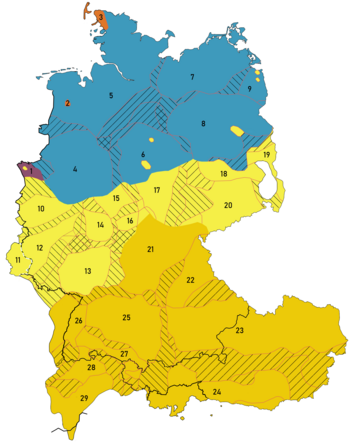High-German
High German is marked by the High German consonant shift, separating it from Low German (Low Saxon) and Low Franconian (including Dutch) within the continental West Germanic dialect continuum. "Low" and "high" refer to the lowland and highland geographies typically found in the two areas.
Classification

As a technical term, the "high" in High German is a geographical reference to the group of dialects that forms "High German" (i.e. "Highland" German), out of which developed Standard German, Yiddish and Luxembourgish. It refers to the Central Uplands (Mittelgebirge) and Alpine areas of central and southern Germany; it also includes Luxembourg, Austria, Liechtenstein, and most of Switzerland. This is opposed to Low German, which is spoken in the lowlands and along the flat sea coasts of the North German Plain.
High German can be subdivided into Upper German (Oberdeutsch) and Central or Middle German (Mitteldeutsch, this includes Luxembourgish, which itself is now a standard language).
High German varieties are distinguished from other West Germanic varieties in that they took part in the High German consonant shift (c. AD 500) to various degrees. To see this, compare the following:
| English | Low German | Standard High German | Consonant shift |
|---|---|---|---|
| pan | Pann | Pfanne | [p] to [p͡f] |
| two | twee | zwei | [t] to [t͡s] |
| make | maken | machen | [k] to [x] |
In the southernmost High Alemannic dialects, there is a further shift: Sack (like English/Low German "sack/Sack") is pronounced [z̥ak͡x] ([k] to [k͡x]).
History
Old High German evolved from about 500 AD. Around 1200 the Swabian and East Franconian varieties of Middle High German became dominant as a court and poetry language (Minnesang) under the rule of the House of Hohenstaufen.
The term "High German" as spoken in central and southern Germany (Upper Saxony, Franconia, Swabia, Bavaria) and Austria was first documented in the 15th century.
Gradually driving back Low German variants since the Early modern period, the Early New High German varieties, especially the East Central German of the Luther Bible, formed an important basis for the development of Standard German.
Family
Divisions between subfamilies within Germanic are rarely precisely defined, because most form continuous clines, with adjacent dialects being mutually intelligible and more separated ones not. In particular, there has never been an original "Proto-High German". For this and other reasons, the idea of representing the relationships between West Germanic language forms in a tree diagram at all is controversial among linguists. What follows should be used with care in the light of this caveat.
- High German
- Central German (German: Mitteldeutsch)
- East Central German
- Thuringian
- Upper Saxon, including Erzgebirgisch
- South Marchian
- Lusatian
- Silesian (now mostly spoken by the German minority in Upper Silesia)
- High Prussian (nearly extinct)
- West Central German
- Central Franconian
- Ripuarian
- Moselle Franconian dialects, including Luxembourgish
- Hunsrik language (from the Hunsrückisch dialect)
- Rhine Franconian
- Palatine, including Lorraine Franconian (France)
- Pennsylvania Dutch (in the United States and Canada)
- Hessian
- Palatine, including Lorraine Franconian (France)
- Central Franconian
- East Central German
- High Franconian, in the transitional area between Central and Upper German
- Upper German (German: Oberdeutsch)
- Alemannic in the broad sense or West Upper German (German: Westoberdeutsch), including Swiss German dialects
- Swabian
- Alemannic in the strict sense
- Low Alemannic, including Alsatian and Basel German
- High Alemannic
- Highest Alemannic
- Bavarian or East Upper German (German: Ostoberdeutsch), including Austrian German dialects
- Northern Bavarian
- Central Bavarian, including Viennese
- Southern Bavarian, including Mócheno in Trentino, Italy
- Cimbrian, nearly extinct
- Hutterite German (in Canada and the United States)
- Lombardic, extinct
- Alemannic in the broad sense or West Upper German (German: Westoberdeutsch), including Swiss German dialects
- Yiddish, evolved from Middle High German
- Central German (German: Mitteldeutsch)
See also
References
- ^ W. Heeringa: Measuring Dialect Pronunciation Differences using Levenshtein Distance. University of Groningen, 2009, pp. 232–234.
- ^ Peter Wiesinger: Die Einteilung der deutschen Dialekte. In: Werner Besch, Ulrich Knoop, Wolfgang Putschke, Herbert Ernst Wiegand (Hrsg.): Dialektologie. Ein Handbuch zur deutschen und allgemeinen Dialektforschung, 2. Halbband. de Gruyter, Berlin / New York 1983, ISBN 3-11-009571-8, pp. 807–900.
- ^ Werner König: dtv-Atlas Deutsche Sprache. 19. Auflage. dtv, München 2019, ISBN 978-3-423-03025-0, pp. 230.
- ^ C. Giesbers: Dialecten op de grens van twee talen. Radboud Universiteit Nijmegen, 2008, pp. 233.
- ^ Compare the definition of "high" in the Oxford English Dictionary (Concise Edition): "... situated far above ground, sealevel, etc; upper, inland, as ... High German".
- ^ E.g.
- Hermann Niebaum, Jürgen Macha, Einführung in die Dialektologie des Deutschen (series: Germanistische Arbeitshefte), 2nd ed., Max Niemeyer Verlag, Tübingen, 2006, p. 220 [1st ed. 1999, 3rd ed. 2014]
- Gabriele Graefen, Martina Liedke-Göbel, Germanistische Sprachwissenschaft: Deutsch als Erst-, Zweit- oder Fremdsprache, 3rd ed., 2020, p. 31.
- Howard Jones & Martin H. Jones, The Oxford Guide to Middle High German, Oxford University Press, 2019, p. 7
- M. O'C. Walshe, A Middle High German reader with grammar, notes, and glossary, Oxford University Press, 1974, p. 3
- ^ Robinson, Orrin. Old English and its Closest Relatives. Routledge, 1994.
- ^ Russ, Charles V.J. The German Language Today: A Linguistic Introduction. Routledge, 1994, p. 15f.
Further reading
- Friedrich Maurer (1942), Nordgermanen und Alemannen: Studien zur germanischen und frühdeutschen Sprachgeschichte, Stammes- und Volkskunde, Strasbourg: Hünenburg, [designation of High German languages as Irminonic].